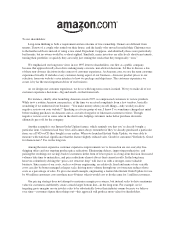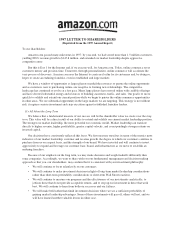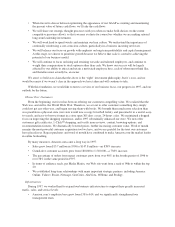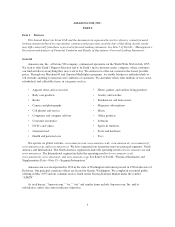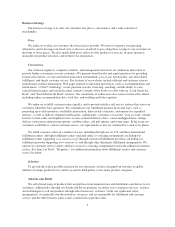Amazon.com 2003 Annual Report Download - page 2
Download and view the complete annual report
Please find page 2 of the 2003 Amazon.com annual report below. You can navigate through the pages in the report by either clicking on the pages listed below, or by using the keyword search tool below to find specific information within the annual report.
To our shareholders:
Long-term thinking is both a requirement and an outcome of true ownership. Owners are different from
tenants. I know of a couple who rented out their house, and the family who moved in nailed their Christmas tree
to the hardwood floors instead of using a tree stand. Expedient, I suppose, and admittedly these were particularly
bad tenants, but no owner would be so short-sighted. Similarly, many investors are effectively short-term tenants,
turning their portfolios so quickly they are really just renting the stocks that they temporarily “own.”
We emphasized our long-term views in our 1997 letter to shareholders, our first as a public company,
because that approach really does drive making many concrete, non-abstract decisions. I’d like to discuss a few
of these non-abstract decisions in the context of customer experience. At Amazon.com, we use the term customer
experience broadly. It includes every customer-facing aspect of our business—from our product prices to our
selection, from our website’s user interface to how we package and ship items. The customer experience we
create is by far the most important driver of our business.
As we design our customer experience, we do so with long-term owners in mind. We try to make all of our
customer experience decisions—big and small—in that framework.
For instance, shortly after launching Amazon.com in 1995, we empowered customers to review products.
While now a routine Amazon.com practice, at the time we received complaints from a few vendors, basically
wondering if we understood our business: “You make money when you sell things—why would you allow
negative reviews on your website?” Speaking as a focus group of one, I know I’ve sometimes changed my mind
before making purchases on Amazon.com as a result of negative or lukewarm customer reviews. Though
negative reviews cost us some sales in the short term, helping customers make better purchase decisions
ultimately pays off for the company.
Another example is our Instant Order Update feature, which reminds you that you’ve already bought a
particular item. Customers lead busy lives and cannot always remember if they’ve already purchased a particular
item, say a DVD or CD they bought a year earlier. When we launched Instant Order Update, we were able to
measure with statistical significance that the feature slightly reduced sales. Good for customers? Definitely. Good
for shareowners? Yes, in the long run.
Among the most expensive customer experience improvements we’re focused on are our everyday free-
shipping offers and our ongoing product price reductions. Eliminating defects, improving productivity, and
passing the resulting cost savings back to customers in the form of lower prices is a long-term decision. Increased
volumes take time to materialize, and price reductions almost always hurt current results. In the long term,
however, relentlessly driving the “price-cost structure loop” will leave us with a stronger, more valuable
business. Since many of our costs, such as software engineering, are relatively fixed and many of our variable
costs can also be better managed at larger scale, driving more volume through our cost structure reduces those
costs as a percentage of sales. To give one small example, engineering a feature like Instant Order Update for use
by 40 million customers costs nowhere near 40 times what it would cost to do the same for 1 million customers.
Our pricing strategy does not attempt to maximize margin percentages, but instead seeks to drive maximum
value for customers and thereby create a much larger bottom line—in the long term. For example, we’re
targeting gross margins on our jewelry sales to be substantially lower than industry norms because we believe
over time—customers figure these things out—this approach will produce more value for shareholders.


